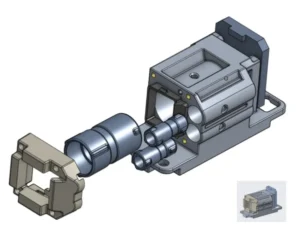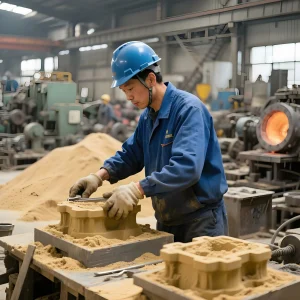Sand Casting vs. Die Casting vs. Investment Casting: Choosing the Right Process for Your Parts
Introduction: Understanding the Three Key Casting Methods
Casting plays a pivotal role in modern manufacturing, especially for producing complex metal parts at scale—and Welleshaft’s custom metal casting services ensure each solution is tailored to your design, material, and volume requirements.. Among the most widely used methods are sand casting, die casting, and investment casting. Each method has its unique advantages, material compatibility, cost structures, and precision levels.
At Welleshaft, our clients frequently ask: Which metal casting process is right for my application? Whether you’re producing high-precision aerospace components, low-volume prototypes, or large, heavy industrial machinery, choosing the right method—sand casting, die casting, or investment casting—can significantly affect your cost, quality, and lead time. That’s why our custom metal casting services are tailored to help you evaluate each option and select the most efficient and cost-effective solution for your specific needs.
Definitions
What is Sand Casting?
Sand casting involves forming a mold using sand and then pouring molten metal into the cavity. After the metal solidifies, the mold is broken to retrieve the cast part. It’s ideal for low-to-medium production and large components.
What is Die Casting?
Die casting uses high-pressure injection to force molten metal into steel molds (dies). It’s commonly used for high-volume production with non-ferrous metals like aluminum, zinc, or magnesium.
What is Investment Casting?
Investment casting, also called lost-wax casting, involves creating a wax model, coating it with ceramic, then melting the wax out to leave a precise mold. This method offers excellent dimensional accuracy and surface finish.
Process Flow Analysis
Sand Casting Process
- Create pattern
- Prepare sand mold
- Pour molten metal
- Cool and break mold
- Clean and finish casting
Die Casting Process
- Prepare steel dies
- Melt metal
- Inject under high pressure
- Cool and eject
- Trim and finish
Investment Casting Process
- Create wax pattern
- Assemble wax tree
- Dip in ceramic slurry
- Burn out wax
- Pour metal
- Break ceramic shell
- Finish
Comparative Analysis: Sand vs. Die vs. Investment Casting
| Factor | Sand Casting | Die Casting | Investment Casting |
| Tooling Cost | Low | High | Moderate |
| Per Unit Cost | Medium | Low (at volume) | High |
| Surface Finish | Rough | Excellent | Excellent |
| Tolerance | Loose | Tight | Very Tight |
| Material Range | Wide (including ferrous) | Non-ferrous | Wide |
| Production Volume | Low to Medium | High | Low to Medium |
| Lead Time | Short | Long | Medium |
What’s the Difference Between Sand Casting, Die Casting, and Investment Casting?
| Casting Type | Key Features | Best For | Surface Finish |
| Sand Casting | Low tooling cost, flexible geometry | Large, heavy parts | Coarse |
| Die Casting | High-speed production, tight tolerances | High-volume aluminum/zinc parts | Smooth, detailed |
| Investment Casting | Excellent precision, complex shapes | Aerospace, medical, turbine blades | Very smooth, precise |
Each method brings different strengths. Sand casting works best for large-scale and cost-sensitive parts. Die casting offers speed and surface quality for high volumes. Investment casting handles tight tolerances and intricate details.
Common Questions (FAQ)
Q1: Which casting method is cheapest? A: For high volume, die casting offers the lowest cost per part. Sand casting has lower upfront tooling costs.
Q2: Can you die cast steel? A: No. Die casting is typically limited to non-ferrous metals due to mold limitations.
Q3: What is best for high-precision aerospace parts? A: Investment casting offers the best dimensional accuracy and surface finish for complex parts.
Q4: Is sand casting suitable for prototyping? A: Yes. Sand casting is ideal for small runs and prototypes due to low tooling investment.
Sand Casting vs Pressure Die Casting vs Lost Wax Casting
Choosing among sand casting, pressure die casting, and lost wax casting (another name for investment casting) depends on your project’s geometry, quantity, and budget. Sand casting has low upfront costs and is ideal for heavy parts. Die casting delivers dimensional stability and repeatability for automotive and consumer products. Investment casting is unmatched for medical tools and aerospace parts needing intricate geometry.
Sand Casting vs Investment Casting Cost Comparison
Which is cheaper: sand casting or investment casting? For large, simple shapes, sand casting remains the most affordable choice. However, investment casting—though more expensive per part—reduces machining costs due to its superior surface finish and tolerance.
Cost Breakdown Table:
| Parameter | Sand Casting | Investment Casting |
| Tooling Cost | Low | Medium |
| Per-Part Cost | Low to Medium | High |
| Surface Finish | Coarse (Ra 6.3+) | Smooth (Ra <1.6) |
| Precision | Moderate | Excellent |
Which Casting Method is Best for Aluminum Parts?
Aluminum is compatible with all three casting processes. For high-volume, lightweight components, die casting aluminum is ideal—especially in automotive and electronics. When intricate detailing or tight tolerances are required, such as in instrument housings, investment casting aluminum alloys shine. For low runs or large volumes, sand casting remains a reliable and cost-effective option. At Welleshaft, our custom metal casting services help you choose the best aluminum casting method based on your product’s complexity, performance, and production goals.
What is the Best Casting Method for Complex Parts?
When producing complex metal parts, the decision often comes down to detail resolution and tolerance. Investment casting is the go-to for precision surgical tools, turbine blades, and aerospace brackets. Die casting also handles complexity well but is limited to non-ferrous metals and higher volumes. Sand casting supports complexity through core usage but with lower precision. Welleshaft’s custom metal casting services guide you in selecting the right process to balance complexity, cost, and performance.

Need guidance for your design?
Sand Casting vs Die Casting: Which is Stronger?
Die casting typically produces stronger parts due to denser structures and better surface bonding, especially for aluminum alloys. In contrast, sand casting can result in more porous finishes, but it’s still effective for larger parts where weight and density are less critical. Welleshaft provides metallurgical analysis and post-treatment options for both.
Low-Volume Production Casting: Sand vs Investment
Prototype casting or small batch production requires flexibility. Investment casting offers near-net-shape geometry, minimizing post-processing, but comes with higher per-unit costs. Sand casting is more cost-effective for iterative designs and low tooling investment.
Our recommendation: If you’re validating design concepts or testing materials, start with sand casting. For functional prototypes, use investment casting.
Surface Finish: Sand vs Die vs Investment
- Surface quality can make or break a final product:
- Sand Casting: Coarse, often requires machining or finishing.
- Die Casting: Excellent, minimal finishing.
- Investment Casting: Superior, often no post-machining needed.
When to Choose Die Casting vs Investment Casting?
Use die casting when:
- Large volumes are needed
- Part geometry is less complex
- Faster cycle time is required
Choose investment casting when:
- High dimensional accuracy is critical
- Complex shapes and thin walls are involved
- You’re working with stainless steel, titanium, or cobalt alloys
FAQ: Pain Points & Answers
Q: What’s the cheapest casting method?
A: Sand casting is the most cost-effective for simple, large parts.
Q: Can investment casting replace die casting for small batches?
A: Yes, especially when detail and accuracy matter more than cost.
Q: What is the best process for aerospace parts?
A: Investment casting due to its tight tolerances and material flexibility.
Q: What’s the lifespan of die casting molds vs investment casting?
A: Die molds can last 80,000–100,000 shots; investment casting tools last fewer but are cheaper.
Q: Can aluminum be used in all processes?
A: Yes, with process-specific advantages.
Welleshaft’s Expertise in Casting Services
At Welleshaft, we offer full-service support across sand casting, die casting, and investment casting. Our engineering team guides you through the optimal process selection based on your material, tolerances, surface requirements, and production volume.
Why Choose Welleshaft?
- Multi-process expertisefor customized solutions
- Rapid prototyping & toolingto shorten development
- Global sourcing & pricing powerto lower your cost
- Quality control systemaligned with ISO & IATF standards
- End-to-end servicefrom DFM analysis to logistics
Our Capabilities
Equipment & Technology
- CNC machining centers
- 5-axis and 3-axis milling machines
- High-pressure die casting machines
- Induction melting furnaces
- Automated inspection systems (CMM, X-ray, etc.)
Certifications
- ISO 9001:2015
- IATF 16949:2016
- RoHS & REACH compliance
- PPAP documentation support
Team Experience
Our engineers have 10+ years of experience in precision casting for industries such as automotive, aerospace, and medical. We’ve delivered thousands of casting solutions that meet tight deadlines and stringent technical requirements.
Ready to start your casting project?

Client Case Study: Automotive Suspension Component
A European OEM required lightweight, corrosion-resistant suspension parts. Welleshaft designed a custom aluminum die casting with 20% cost savings vs. their previous supplier and faster delivery times. We managed DFM, mold manufacturing, casting, machining, and final inspection.
Application Scenarios
- Automotive:Gearboxes, engine brackets, suspension components
- Aerospace:Turbine blades, housings
- Industrial Equipment:Pumps, valve bodies, manifolds
- Medical Devices:Implant tools, surgical instruments
Why Work with Welleshaft?
- In-house engineering + manufacturing = faster lead times
- Global sourcing = better pricing
- One-stop casting solution = less complexity for you
- Trusted by global OEMs across 30+ countries
Ready to choose the right casting method for your project?
Contact Welleshaft today to get a free consultation and DFM analysis.
Or email us at rocky@welleshaft.com for expert support within 24 hours
John Liang is the technical director at Welleshaft, with 15+ years of experience in precision casting and mechanical component manufacturing. He leads a cross-national team that serves aerospace, automotive, and medical sectors.

